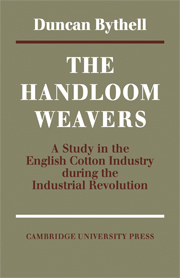Book contents
- Frontmatter
- Contents
- Preface
- Introduction
- Map of the weaving towns and villages of north-east Lancashire in 1821
- 1 Problems and sources
- 2 The organization of the industry
- 3 The labour force
- 4 The coming of the powerloom
- 5 Wages: (I) The piece-rate
- 6 Wages: (II) Earnings and the standard of living
- 7 Public opinion and the handloom weavers
- 8 Organized industrial action among the cotton handloom weavers
- 9 The weavers and radical politics
- 10 The problem of poverty
- 11 Displacement and disappearance
- Appendix 1 Some piece-rate series
- Appendix 2 The piece-rate and the price of food
- Appendix 3 G. H. Wood's estimates of average weekly earnings
- Bibliography
- Index
7 - Public opinion and the handloom weavers
Published online by Cambridge University Press: 07 October 2011
- Frontmatter
- Contents
- Preface
- Introduction
- Map of the weaving towns and villages of north-east Lancashire in 1821
- 1 Problems and sources
- 2 The organization of the industry
- 3 The labour force
- 4 The coming of the powerloom
- 5 Wages: (I) The piece-rate
- 6 Wages: (II) Earnings and the standard of living
- 7 Public opinion and the handloom weavers
- 8 Organized industrial action among the cotton handloom weavers
- 9 The weavers and radical politics
- 10 The problem of poverty
- 11 Displacement and disappearance
- Appendix 1 Some piece-rate series
- Appendix 2 The piece-rate and the price of food
- Appendix 3 G. H. Wood's estimates of average weekly earnings
- Bibliography
- Index
Summary
THE DEBATE ON ‘MACHINERY’
Detailed analysis of the economic problems which the cotton handloom weavers came ultimately to face has, on the whole, enabled a less horrifying picture of their sufferings to be painted. Yet even with the emotional varnish removed, and the exaggeration curbed, their fate remains a sad one. If their economic wellbeing did not suffer an unbroken decline from the beginning of the nineteenth century; if the casual nature of much of the employment and the weavers' increasingly archaic attitude to work make direct comparison with the new factory operatives difficult; if they had suffered horribly at times even before the powerloom came to affect their position; and if the location of industry as much as its technical development tended to aggravate their problems, the suffering entailed in the elimination of the handloom weavers as an element in economic organization is still the most disquieting aspect of the English industrial revolution. Theirs was, if not the first, certainly the largest case of redundancy or technological unemployment in our recent economic history; the contraction of the cotton industry in our time, particularly in the 1920s and 1930s, affords an interesting parallel.
The extensive distress which certainly existed among the handloom weavers even before the 1820s has indicated that their problems did not arise simply from the coming of new machines; indeed, it could be maintained that their long-term prospects were distinctly uninviting so long as weaving remained a domestic trade bedevilled by all the problems of underemployment and exploitation inherent in such occupations.
- Type
- Chapter
- Information
- The Handloom Weavers , pp. 139 - 175Publisher: Cambridge University PressPrint publication year: 1969



